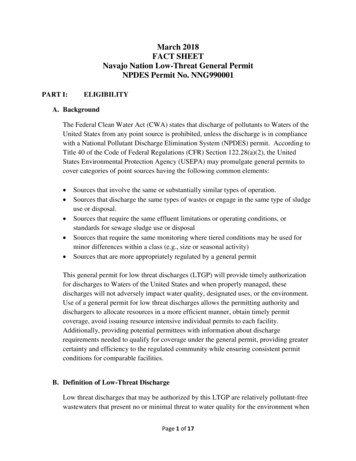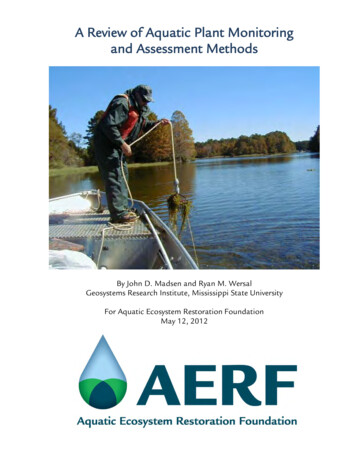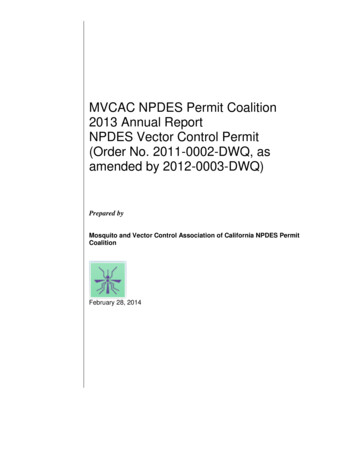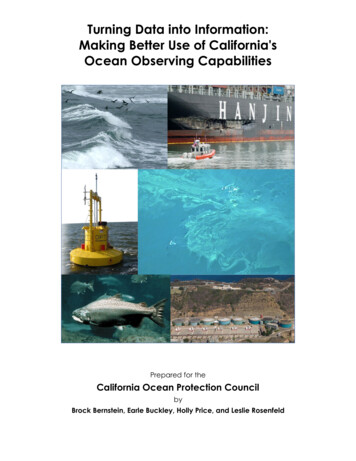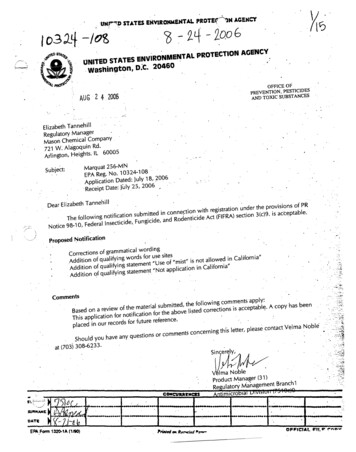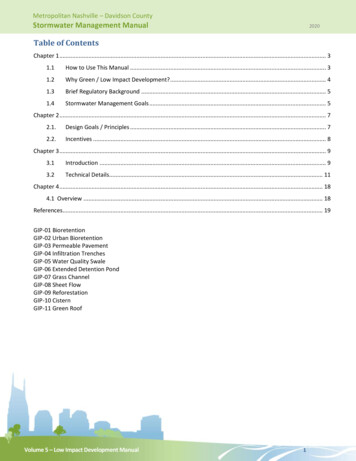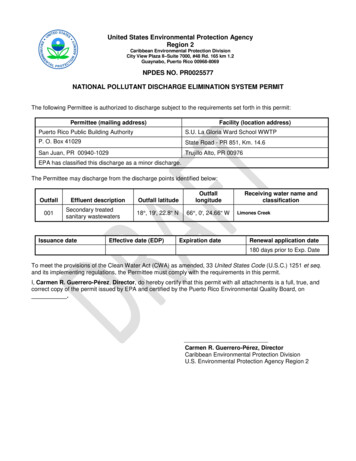
Transcription
United States Environmental Protection AgencyRegion 2Caribbean Environmental Protection DivisionCity View Plaza II–Suite 7000, #48 Rd. 165 km 1.2Guaynabo, Puerto Rico 00968-8069NPDES NO. PR0025577NATIONAL POLLUTANT DISCHARGE ELIMINATION SYSTEM PERMITThe following Permittee is authorized to discharge subject to the requirements set forth in this permit:Permittee (mailing address)Facility (location address)Puerto Rico Public Building AuthorityS.U. La Gloria Ward School WWTPP. O. Box 41029State Road - PR 851, Km. 14.6San Juan, PR 00940-1029Trujillo Alto, PR 00976EPA has classified this discharge as a minor discharge.The Permittee may discharge from the discharge points identified below:Outfall001Effluent descriptionSecondary treatedsanitary wastewatersIssuance dateOutfall latitudeOutfalllongitude18 , 19′, 22.8″ N66 , 0′, 24.66″ WEffective date (EDP)Expiration dateReceiving water name andclassificationLimones CreekRenewal application date180 days prior to Exp. DateTo meet the provisions of the Clean Water Act (CWA) as amended, 33 United States Code (U.S.C.) 1251 et seq.and its implementing regulations, the Permittee must comply with the requirements in this permit.I, Carmen R. Guerrero-Pérez, Director, do hereby certify that this permit with all attachments is a full, true, andcorrect copy of the permit issued by EPA and certified by the Puerto Rico Environmental Quality Board, on.Carmen R. Guerrero-Pérez, DirectorCaribbean Environmental Protection DivisionU.S. Environmental Protection Agency Region 2
PRPBA – S.U. La Gloria Ward SchoolNPDES NO. PR0025577CONTENTSPART I.BackgroundPART II.Effluent Limitations and Monitoring RequirementsPART III. Reporting Requirements and Compliance DeterminationPART IV. Standard and Special ConditionsAttachment A: DefinitionsAttachment B: Standard Conditions
PRPBA – S.U. La Gloria Ward SchoolNPDES NO. PR0025577PART I. BACKGROUNDA. Rationale for Permit Requirements. This permit is issued pursuant to CWA section 402 and implementingregulations adopted by EPA. EPA developed the requirements in this permit on the basis of informationsubmitted as part of the complete application and monitoring and reporting requirements, and other availableinformation. This permit contains TBELS based on a case-by-case determination using Best ProfessionalJudgment (BPJ) in accordance with 40 CFR 125. and WQBELs based on the Puerto Rico Water QualityStandards Regulation (PRWQS), as amended. The accompanying Fact Sheet contains detailed informationand rationale for permit requirements.B. Water Quality Certificate. Pursuant to CWA section 401(a)(1), after due consideration of the applicableprovisions established in the PRWQS and CWA sections 208(e), 301, 302, 303, 304(e), 306 and 307, onFebruary 10, 2016 the Puerto Rico Environmental Quality Board (EQB) certified that reasonable assurancewas determined that the allowed discharge will not cause violations to the applicable water quality standardsfor the receiving water body if the limitations and monitoring requirements in the Water Quality Certificate aremet. Additional requirements could be required to comply with other sections of the CWA.C. Impaired Waters and Total Maximum Daily Loads (TMDLs). This facility discharges to an impaired water.A TMDL have been developed and approved by EPA for the following parameter: Fecal Coliforms. Theeffluent limitations in this permit are consistent with the assumptions and requirements of any WLA assignedto the Permittee [40 CFR 122.44(d)(1)(vii)(B)].D. Antidegradation and Anti-backsliding Requirements. The discharge is consistent with the federal antidegradation provisions at 40 CFR 131.12, 72 Federal Register 238 (December 12, 2007, pages 7051770526), and EQB’s Anti-Degradation Policy Implementation Procedure in Attachment A of PRWQS. Someeffluent limitations in this permit are less stringent that those in the previous permit and the rationale for theselimitations are provided in the Fact Sheet for this permit. An anti-backsliding analysis has been conducted andEPA has determined that these limitations are consistent with the anti-backsliding requirements at 40 CFR122.44(l).E. Public Participation. Federal regulations at 40 CFR 124 require EPA to consider all significant comments onthe draft permit received during the public comment period in the development of the final permit. Anycomments received will be provided in a Responsiveness Summary issued with the final permit.Page 1 of 20
PRPBA – S.U. La Gloria Ward SchoolNPDES NO. PR0025577PART II. EFFLUENT LIMITATIONS AND MONITORING REQUIREMENTSA. Final Effluent Limitations—Outfall Number 001The Permittee must maintain compliance with the following effluent limitations at Outfall 001. The discharge at Outfall 001 is composed of secondarytreated sanitary wastewaters.Effluent Limitations TableEffluent limitationsParameterEffluent BOD, 5-day (20ºC)ArsenicColorCopperDissolved OxygenFecal ColiformsFlowMonitoring aximumdailymg/Lkg/day5.0-----45--minimum% nthmg/L(colonies/100 ml)%ExceedingLimitMGD---- Month(3)----0.006MeteredContinuous(1)Nitrate plus Nitriteµg/L----10,000Grab1/MonthOil and Greasemg/L---Minimum 6Maximum ual Chlorineµg/L--Page 2 of 207.5Footnotes(5)(5)(6)
PRPBA – S.U. La Gloria Ward SchoolNPDES NO. PR0025577Effluent limitationsMonitoring ximumdailySulfideSuspended, Colloidal or SettleableSolidsSurfactantsTemperatureTotal Ammoniaµg/L----2mL/L----MonitorGrab1/Dayµg/L Cmg/L(colonies/100 nal(8)(8)(8)(8)(8)(8)(8)(8)Total ColiformsTotal Dissolved SolidsTotal NitrogenEffluent TSSTotal Phenolmg/Lkg/dayminimum% µg/LFootnotes(4)(7)(5)Notes, Footnotes and AbbreviationsDashes (--) indicate there are no effluent limitations or monitoring requirements for this parameter.All limitations expressed in mass calculated from concentration-based limitations are calculated according to: mass (kg/day) Flow (MGD) x concentration (mg/L) x 3.78 (kg/L)/(mg)(mgd)(1) All flow measurements must achieve accuracy within the range of plus or minus ( ) 10%.(2) This average monthly effluent limitation is expressed as a geometric (or log) mean, based on a minimum of five samples collected for any 30-day period.(3) For the maximum daily effluent limitation, no more than 20% of the single samples of fecal coliform collected during any 30-day period must exceed a MPN of 400 per 100 ml. All singlesamples must be reported as laboratory results attached to the DMR.Page 3 of 20
PRPBA – S.U. La Gloria Ward SchoolNPDES NO. PR0025577(4) See Special Condition Number 10.(5) 30 day average, in addition, the permittee shall achieve the 30-day average percent removal of not less than 85%.(6) See special condition 6 and 7.(7) The coliforms geometric mean of a series of representative samples (at least five samples) of the waters taken sequentially shall not exceed 10,000 colonies/100mL.(8) The permittee shall implement a monthly monitoring program using the analytical method approved by EPA with the lowest possible detection level, in accordance with Rule 1306.2(C) of thePRWQSR as amended, for one (1) year period, after which they will be conducted annually. The monitoring program shall commence no later than thirty (30) days after the EQB’s writtenapproval of the Quality Assurance Project Plan (QAPP). The QAPP must be submitted for evaluation and approval of EQB not later than thirty (30) days after the EDP. The results of themonitoring program shall be submitted to EQB’s Water Quality Area and EPA-Region 2 Clean Water Division, no later than sixty (60) days of completion of the one year monitoring program.Based on the evaluation of the results obtained, EQB will determine if an effluent limitation is necessary for this parameter. In such case the WQC will be reopened to include the applicableeffluent limitation.Page 4 of 20
PRPBA – S.U. La Gloria Ward SchoolNPDES NO. PR0025577B. Narrative LimitationsIn accordance with 40 CFR 122.44(d), the permit establishes the following narrative limitations.1. Except by natural causes, no heat may be added to the waters of Puerto Rico, which would cause thetemperature of any site to exceed 90 F (32.2 C).2. The waters of Puerto Rico must not contain floating debris, scum, or other floating materials attributable todischarges in amounts sufficient to be unsightly or deleterious to the existing or designated uses of the waterbody.3. Solids from wastewater sources must not cause deposition in or be deleterious to the existing or designateduses of the waters.4. Taste and odor-producing substances must not be present in amounts that will interfere with primary contactrecreation, interfere with the use for potable water, or will render any undesirable taste or odor to edibleaquatic life.5. The waters of Puerto Rico must be substantially free from floating non petroleum oils and greases as well aspetroleum derived oils and greases.C. Monitoring Requirements1. Effluent monitoring and analyses must be conducted in accordance with EPA test procedures approved under40 CFR Part 136, Guidelines Establishing Test Procedures for the Analysis of Pollutants Under the CleanWater Act, as amended. For situations where there may be interference, refer to Solutions to AnalyticalChemistry Problems with Clean Water Act Methods (EPA 821-R-07-002). For effluent analyses, the Permitteemust use a Minimum Level (ML) that is lower than the effluent limitations described in Effluent LimitationsTable of this permit. If all published MLs are higher than the effluent limitations, the Permittee must use thetest method procedure with the lowest ML. The Permittee must ensure that the laboratory uses a standardcalibration where the lowest standard point is equal to or less than the ML. Priority pollutant analysis formetals must measure total metal, except as provided under 40 CFR 122.45(c). EPA method 1631E must beused for mercury analysis. Priority pollutant analysis for benzene, ethylbenzene, toluene and xylene mustemploy either EPA Method 602 or 624. Effluent analysis for xylene must measure total xylene.2. The regulations at 40 CFR 122.48 require that all NPDES permits specify monitoring and reportingrequirements. All monitoring must be in accordance with Standard Condition 10. Monitoring and records inAttachment B of this permit.3. Sampling point for Outfall 001 must be located immediately after the primary flow measuring device of theeffluent of the treatment system.4. The Permittee must develop and implement a quality assurance (QA) plan for laboratory analyses for effluentand/or receiving water monitoring.Page 5 of 11
PRPBA – S.U. La Gloria Ward SchoolNPDES NO. PR0025577D. Monitoring LocationsThe Permittee must establish the following monitoring locations to demonstrate compliance with the effluentlimitations and other requirements in this permit:Monitoring Locations TableOutfallMonitoring locationMonitoring location descriptionEFF-001The sampling point for discharge 001 shall be locatedimmediately after the primary flow-measuring device of theeffluent of the treatment system.001PART III. REPORTING REQUIREMENTS AND COMPLIANCE DETERMINATIONA. Reporting Requirements1. Standard Conditions. The Permittee must comply with all Standard Conditions in section IV.A below andAttachment B of this permit related to monitoring, reporting, and recordkeeping.2. Monitoring data submission. The Permittee must either submit monitoring data and other reports to EPA inhard copy form, or report electronically using NetDMR, a web-based tool that allows Permittees toelectronically submit discharge monitoring reports (DMRs) and other required reports via a secure internetconnection. Specific requirements regarding submittal of data and reports in hard copy form and for submittalusing NetDMR are described below:a. Submittal of Reports in Hard Copy Form. Hard copy DMR submittals must be submitted in accordancewith Standard Condition 12.d. Monitoring reports in Attachment B of this permit. The Permittee will reportthe results for all monitoring specified in this permit. The Permittee must submit monthly DMRs includingthe results of all required monitoring using EPA-approved test methods or other test methods specified inthis permit as required by III.A.3. below. If the Permittee monitors any pollutant more frequently thanrequired by the permit using test procedures approved under 40 CFR Part 136, or another methodrequired for an industry-specific waste stream under 40 CFR subchapters N or O, the results of suchmonitoring must be included in the calculation and reporting of the data submitted in the DMR or sludgereporting form specified by EPA.b. Submittal of Reports Using NetDMR. DMRs and reports submitted electronically to EPA must be doneusing NetDMR at http://www.epa.gov/netdmr. All reports required under the permit must be submitted toEPA as an electronic attachment to the DMR. Once a Permittee submits DMRs and reports usingNetDMR, it is not required to submit hard copies of DMRs or other reports to EPA and the EQB. However,Permittees must continue to send hard copies of reports other than DMRs to the EQB until further noticefrom the EQB.c.Timing of submissions. DMRs must be submitted to EPA no later than the 28th day of the monthfollowing the completed reporting period. Monitoring results must be summarized and reported on EPADMR Form No. 3320-1, postmarked no later than the 28th day of the month following the completedmonitoring period. The first report is due the DATE (i.e., 28th day of month after EDP) .3. Submission Requirements. If submitting reports in hard copy form, DMRs must be signed and certified asrequired by Standard Condition 11. Signatory requirements in Attachment B of this permit. The Permitteemust submit the original signed DMR to 3.a below and duplicate signed copies and all other reports requiredin this permit to 3.b below:a. U.S. Environmental Protection Agency, Region 2290 Broadway, 21st FloorNew York, NY 10007-1866Attention: Compliance Assistance and Program Support Branchb. Puerto Rico Environmental Quality BoardP.O. Box 11488Santurce, PR 00910Attention: Water Quality BureauPage 6 of 11
PRPBA – S.U. La Gloria Ward SchoolNPDES NO. PR00255774. Analytical Determinations. The Permittee must report the results on the DMR of analytical determinationsfor the presence of chemical constituents in a sample using the following reporting protocols:a. Sample results greater than or equal to the ML must be reported as measured by the laboratory (i.e., themeasured chemical concentration in the sample).b. Sample results less than the ML must be reported as ML, where the ML equals the ML reported by thelaboratory.c.Permittees are to instruct laboratories to establish calibration standards so that the ML value (or itsequivalent if there is differential treatment of samples relative to calibration standards) is the lowestcalibration standard. At no time is the Permittee to use analytical data derived from extrapolation beyondthe lowest point of the calibration curve.5. Bacterial Monitoring. For bacterial monitoring, the Permittee must report on the DMR the calculatedgeometric mean and the percentage of individual samples that exceeded the single-sample maximumcriterion. The geometric mean must be calculated on the basis of five grab samples taken within the calendarmonth and as described in Attachment A. Definitions of this permit. The Permittee must report on anattachment to the DMR the analytical results of each of the five individual sample measurements, thecalculated geometric means using these individual samples, and the percentage of individual samples thatexceed the single sample maximum criterion.6. Transparency. The Permittee must make publicly available by posting online on a website a copy of the finalissued permit for PRPBA-La Gloria Ward School. Enhanced transparency and availability of PRPBA-La GloriaWard School permit information will provide stakeholders with more timely and complete information aboutpotential sources of water pollution and measures required to control discharges from the facility. Within sixty(60) days after the Effective Date of the NPDES Permit (EDP), the permittee must submit to the EPA the URLwebsite of the posting of the copy of the final NPDES permit.B. Compliance DeterminationCompliance with effluent limitations contained in this permit will be determined as specified below:1. General. Compliance with effluent limitations for priority pollutants must be determined using samplereporting protocols defined in section III. A and Attachment A. Definitions.2. Average Monthly Discharge Limitation (AML). If the average or, when applicable, the median of dailydischarges that were measured in a calendar month exceeds the AML for a given parameter, this willrepresent a single violation, though the Permittee will be considered out of compliance for each day of thatmonth for that parameter (e.g., resulting in 31 days of noncompliance in a 31-day month). If only a singlesample is taken during the calendar month and the analytical result for that sample exceeds the AML, thePermittee will be considered out of compliance for that calendar month. The Permittee will be considered outof compliance for only the days when the discharge occurs. For any one calendar month during which nosample (daily discharge) is taken yet sampling is required, the Permittee will be considered out of compliancefor that calendar month.3. Average Weekly Discharge Limitation (AWL). If the average or, when applicable, the median of dailydischarges over a calendar week exceeds the AWL for a given parameter, this will represent a singleviolation, though the Permittee will be considered out of compliance for each day of that week for thatparameter, resulting in 7 days of noncompliance. If only a single sample is taken during the calendar weekand the analytical result for that sample exceeds the AWL, the Permittee will be considered out of compliancefor that calendar week. The Permittee will be considered out of compliance for only the days when thedischarge occurs. For any one calendar week during which no sample (daily discharge) is taken yet samplingis required, the Permittee will be considered out of compliance for that calendar week.4. Maximum Daily Discharge Limitation (MDL). If a daily discharge exceeds the MDL for a given parameter,the Permittee will be considered out of compliance for that parameter for that 1 day only in the reportingperiod. For any one day during which no sample is taken yet a sampling is required, the Permittee will beconsidered out of compliance for that day.5.Page 7 of 11
PRPBA – S.U. La Gloria Ward SchoolNPDES NO. PR0025577PART IV. STANDARD AND SPECIAL CONDITIONSA. Standard Conditions1. Standard Conditions Applicable to All Facilitiesa. The Permittee must comply with all Standard Conditions that apply to all NPDES permits in accordancewith 40 CFR 122.41 (Attachment B of this permit), and additional conditions applicable to specificcategories of facilities in accordance with 40 CFR 122.42.b. The Permittee must comply with the Reopener Clause in Standard Condition 17. Reopener clause fortoxic effluent limitations, in Attachment B of this permit, which applies to all NPDES permits in accordancewith 40 CFR 122.44(b). EPA reserves the right to revoke and reissue or modify this permit to establisheffluent limitations, additional monitoring, schedules of compliance or other permit conditions based onnew information, including any changes to the final Water Quality Certificate from EQB.2. Standard Conditions Applicable to Specific Facilities—Notification LevelsExisting manufacturing, commercial, mining, and silvicultural dischargers must notify EPA as soon as they knowor have reason to believe [40 CFR 122.42(a)]:a. That any activity has occurred or will occur that would result in the discharge, on a routine or frequentbasis, of any toxic pollutant that is not limited in this permit, if that discharge will exceed the highest of anyone of the following notification levels [40 CFR 122.42(a)(1)]:1) 100 micrograms per liter (μg/L) [40 CFR 122.42(a)(1)(i)].2) 200 μg/L for acrolein and acrylonitrile; 500 μg/L for 2,4 dinitrophenol and 2 methyl 4,6 dinitrophenol;and 1 milligrams per liter (mg/L) for antimony [40 CFR 122.42(a)(1)(ii)].3) Five times the maximum concentration value reported for that pollutant in the DMR [40 CFR122.42(a)(1)(iii)].4) The level established by EPA in accordance with 40 CFR 122.44(f) [40 CFR 122.42(a)(1)(iv)].b. That any activity has occurred or will occur that would result in the discharge, on a non-routine orinfrequent basis, of any toxic pollutant that is not limited in this permit, if that discharge will exceed thehighest of any one of the following notification levels [40 CFR 122.42(a)(2)]:1) 500 μg/L [40 CFR 122.42(a)(2)(i)].2) 1 mg/L for antimony [40 CFR 122.42(a)(2)(ii)].3) Ten times the maximum concentration value reported for that pollutant in the DMR [40 CFR122.42(a)(2)(iii)].4) The level established by EPA in accordance with 40 CFR 122.44(f) [40 CFR 122.42(a)(2)(iv)].B. Special Conditions1. Special Conditions from the Water Quality Certificate1.The flow of discharge 001 shall not exceed the limitation of 22.71 m3/day (0.006 MGD) as dailymaximum. No increase in flow of discharge 001 shall be authorized without a recertification from theEnvironmental Quality Board (EQB). 1,42.No changes in the design or capacity of the treatment system will be permitted without the previousauthorization of EQB. 43.Within thirty (30) days after the Effective Date of the NPDES Permit (EDP), the permittee must submitto the EQB, for its evaluation and approval, the engineering report, plans and specifications of theimprovements made to the constructed treatment system. 44.Prior to the construction of any additional treatment system, or the modification of the existing one, thepermittee shall obtain the approval from EQB of the engineering report, plans and specifications. 4Page 8 of 11
PRPBA – S.U. La Gloria Ward SchoolNPDES NO. PR00255775.The permittee shall install, maintain and operate all water pollution control equipment in such manneras to be in compliance with the applicable Rules and Regulations. 1,36.No toxic substances shall be discharged, in toxic concentrations, other than those allowed as specifiedin the NPDES permit. Those toxic substances included in the permit renewal application, but notregulated by the NPDES permit, shall not exceed the concentrations specified in the applicableregulatory limitations. 2,37.The waters of Puerto Rico shall not contain any substance attributable to discharge 001, at suchconcentration which, either alone or as result of synergistic effects with other substances, is toxic orproduces undesirable physiological responses in human, fish or other fauna or flora. 28.The discharge 001 shall not cause the presence of oil sheen in the receiving water body. 29.All sample collection, preservation, and analysis shall be carried out in accordance with the Title 40 of theCode of Federal Regulations (40 CFR), Part 136. A licensed chemist authorized to practice theprofession in Puerto Rico shall certify all chemical analyses. All bacteriological tests shall be certified by amicrobiologist or licensed medical technologist authorized to practice the profession in Puerto Rico. 1,310.The permittee shall use the analytical method approved by the Environmental Protection Agency(EPA), with the lowest possible detection limit, in accordance with the 40 CFR, Part 136 for Sulfide (asS). Also, the permitteee shall complete the calculation specified in Method 4500-S-2 F, Calculation ofUn-ionized Hydrogen Sulfide, of Standard Methods 18th Edition, 1992, to determine the concentrationof the undissociated H2S. If the sample results of Dissolved Sulfide are below the detection limit of theEPA approved method established in the 40 CFR, Part 136, then, the limit concentration ofundissociated H2S shall be reported as “below detection limit”. 1,311.The flow-measuring device for the discharge 001, shall be periodically calibrated and properlymaintained. Calibration and maintenance records must be kept in compliance with the applicableRules and Regulations. 3,412.The sampling point for discharge 001 shall be located immediately after the flow-measuring device ofthe effluent of the treatment system.13.The sampling point for discharge 001 shall be labeled with an 18 inches per 12 inches (minimumdimensions) sign that reads as follow:“Punto de Muestreo para la Descarga 001”14.All water or wastewaters treatment facilities, whether publicly or privately owned, must be operated bya person licensed by the Potable Water and Wastewaters Treatment Plants Operators ExaminingBoard of the Commonwealth of Puerto Rico.315.This special condition shall not become in effect until EQB has determined the applicability to therespective facility and has notified the permittee and EPA, in writing, of the necessity to comply withthis special condition.No later than one hundred eighty (180) days after the Effective Date of this NPDES Permit Condition(EDPC), the permittee shall conduct semiannually acute toxicity tests for a period of one (1) year, afterwhich the tests shall be performed annually, of its wastewaters discharge through outfall serial number001, in accordance with the following: 3a. The test species should be the Fathead Minnow (Pimephales promelas) and Cladocera (Daphniamagna). The tests should be static renewal type.Page 9 of 11
PRPBA – S.U. La Gloria Ward SchoolNPDES NO. PR0025577b. The toxicity tests shall be conducted in accordance with the EPA publication, EPA-821-R-02-012Methods for Measuring the Acute Toxicity of Effluents and Receiving Waters to Freshwater andMarine Organisms (Fifth Edition), October 2002, or the most recent edition of this publication, ifsuch edition is available.c. The tests shall provide a measure of the acute toxicity as determined by the wastewatersconcentration, which cause 50 percent mortality of the test organisms over a 48-hours period. Thetest results shall be expressed in terms of Lethal Concentration (LC) and reported as 48-hours,LC50.d. A procedure report shall be submitted within ninety (90) days after EDPC. The followinginformation shall be included in the procedure report:1.An identification of the organizations responsible for conducting the tests and the species tobe tested.2.A detailed description of the methodology to be utilized in the conduct of the tests, includingequipment, sample collection, dilution water and source of test organisms.3.A schematic diagram, which depicts the effluent sampling location in relation to thewastewaters treatment facility and discharge monitoring point.4.If stream flow monitoring is required, the method used to obtain the stream flow data inestimating the low flow of seven consecutive days with a recurrence interval of two-years(7Q2).e. The results of the tests conducted shall be submitted to EPA Region 2 and EQB within sixty (60)days of completion of each test. Based on the review of the test results, the RegionalAdministrator of EPA or the EQB can require additional toxicity tests, including chronic tests andtoxicity/treatability studies, and may impose toxicity limitations.16.The solid wastes (sludge, screenings and grit) generated due to the operation of the treatment system,shall be:a. Disposed in compliance with the applicable requirements established in the 40 CFR, Part 257. Asemiannual report shall be submitted to EQB and EPA notifying the method or methods used todispose the solid wastes generated in the facility. Also, copy of the approval or permit applicable tothe disposal method used shall be submitted, if any.b. Transported adequately in such way that access is not gained to any water body or soil. In the eventof a spill of solid wastes on land or into a water body, the permittee shall notify the Point SourcesPermits Division of EQB’s Water Quality Area in the following manners:1. By telephone communication within a term no longer than twenty-four (24) hours after the spill(787-767-8073).2. By letter, within a term no longer than five (5) days after the spill.These notifications shall include the following information:a.b.c.spill material,spill volume,measures taken to prevent the spill material to gain access to any water body.This special condition does not relieve the permittee from its responsibility to obtain thecorresponding permits from the EQB’s Land Pollution Control Area and other state and federalagencies, if any. 4, 5Page 10 of 11
PRPBA – S.U. La Gloria Ward School17.NPDES NO. PR0025577A log book must be kept for the material removed from the PRPBA-La Gloria Ward SchoolWastewaters Treatment Plant, such as sludge, screenings and grit, detailing the following items:a.b.c.d.e.removed material, date and source of it;approximate volume and weight;method by which it is removed and transported;final disposal and location;person that performs the service.A copy of the Non-Hazard
Puerto Rico Public Building Authority S.U. La Gloria Ward School WWTP P. O. Box 41029 State Road - PR 851, Km. 14.6 San Juan, PR 00940-1029 Trujillo Alto, PR 00976 EPA has classified this discharge as a minor discharge. The Permittee may discharge from the discharge points identified below: Outfall Effluent description Outfall latitude
